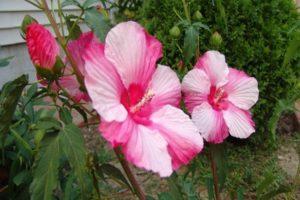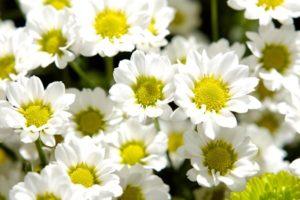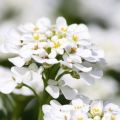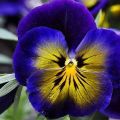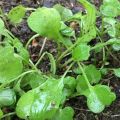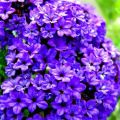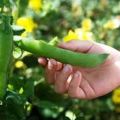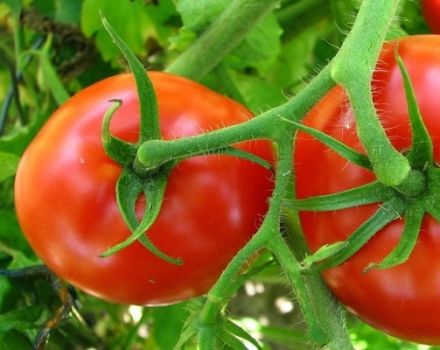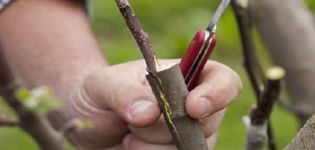Description of Kokhia varieties, planting and care in the open field, growing from seeds
Cochia is a unique culture similar to miniature cypress trees. The plant was initially cultivated in eastern countries, but since the late 90s, it has gained popularity in the post-Soviet space. It is grown for the purpose of decorating the territory, using it as a natural medicine. Beforehand, you should familiarize yourself with the rules for planting and caring for a kochia. The tips below will help even an inexperienced summer resident grow a culture safely.
Description and characteristics of kochia
Kokhia is a perennial belonging to the Marev family. He first got divorced in East Asia, South Africa. In simple terms, it is called "summer cypress", "izenya", "annual cypress", "prutnyak".
The culture is planted on curbs, flower beds, fences. The bush grows quickly, it only requires regular pruning.
Kochii are slender, lush, widely used in decorating country estates. The height of the bushes is 60-80 cm, depending on the variety. Pollen falls in early June and lasts until the first frost. The bushes have many thin, branched shoots. At the base is an erect, woody stalk.
Many consider the plant to be coniferous, because of the narrow leaves that resemble needles. Emerald foliage is soft, pleasant to the touch, with pubescence. Young bushes are light green in color, but during pollen, they turn pinkish or crimson. Inflorescences are small, inconspicuous, collected in panicles. After pollination, tiny nuts grow. Each contains a seed that retains germination for 2 years.
Kokhia species
Gardeners have about 80 varieties. In the CIS countries, only the following types are popular.
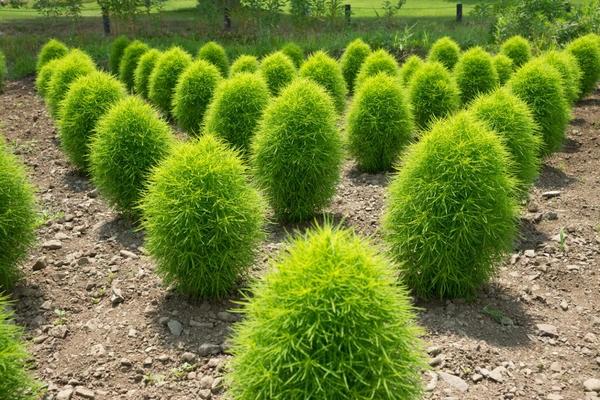
Creeping
This is a less decorative type of kochia, the bushes grow 5-6 cm tall. The plant itself is dense, branches spread in different directions along the surface.
Woolly flowered
The bushes are annual, reaching 0.5 meters in height. The branches are reddish or yellow-green, with curly pubescence.
Densely flowered
The annual bush grows over 1 meter in height.The inflorescences are covered with a mass of small whitish hairs, which creates a shaggy appearance.
Venichnaya
Coronal kochia forms spherical shrubs and is resistant to dry periods. In autumn, the bush becomes burgundy. The variety, unlike its counterparts, can withstand frosts down to -10 degrees. Bushes bloom until late autumn.
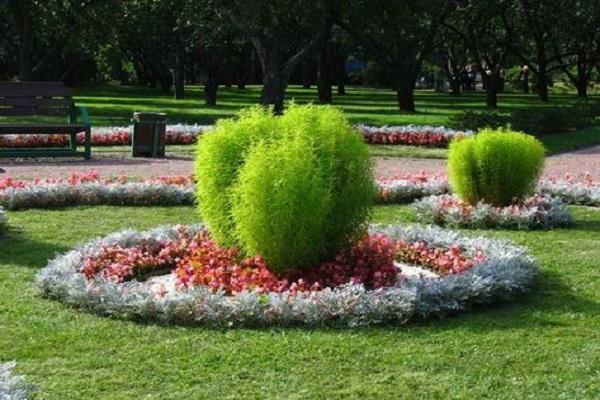
Hairy
The culture forms slender, elongated bushes 100 * 70 cm. The leaves are narrow, with an edge, in the spring of a salad tone. With the arrival of autumn, the plant takes on a burgundy hue. It prefers sunny areas and is able to grow on poor soils.
Childs
A spherical variety of small sizes, up to 50 cm high. Sprawling branches, densely covered with lettuce foliage. The plant never changes color.
Sultan
An annual species of compact size, rounded, growing up to 100 cm. The process of forming the bushes is fast, the variety takes root well in new areas. With the arrival of autumn, emerald tones change to burgundy.
Acapulco Silver
Shrubs are spherical, covered with green leaves with silvery edging. In the fall, they become crimson.
Nephritis
The plant is famous for its fast growth, its height is 1 meter. Herbaceous shade does not change during the year. With the help of the variety, they create marvelous green sculptures.
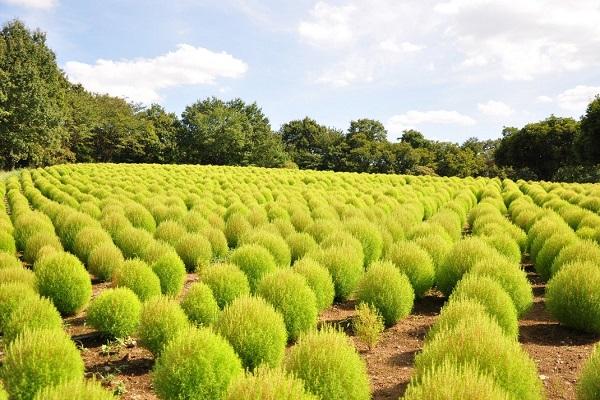
Flame
This is an annual columnar bush, the height is about 100 cm. By autumn, the leaves become crimson. The variety is resistant to frost down to -10.
Shilzy
The bushes are dense, up to 1 meter high, 60 cm in diameter. In summer they change from green to purple-red.
Berning Bush
The bushes are distinguished by their red color since June. Their height reaches about 80 cm.
Scoparia
Annual prefers warm, pollen is not pronounced. The leaves turn copper-red in autumn.
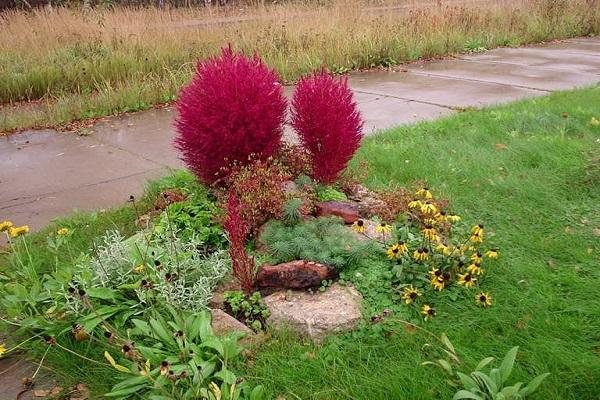
Green Forest
An annual bush, elongated in shape, with bright green leaves. During the growing season, the shade does not change.
Green Lace
The variety is distinguished by an elongated, oval shape. The flower of the leaves is emerald, does not change.
Cyprus
The variety is distinguished by a green shade of bushes, thick leaves. The plant grows up to 80 cm tall.
Growing kochia in the garden
Cochia is usually grown only by seeds. Having once planted a bush in the garden, you can no longer buy them. The culture grows on its own. Seeds sprout quickly, almost all of 100 seeds germinate. Their shelf life is about 1.5 years. After, germination decreases.
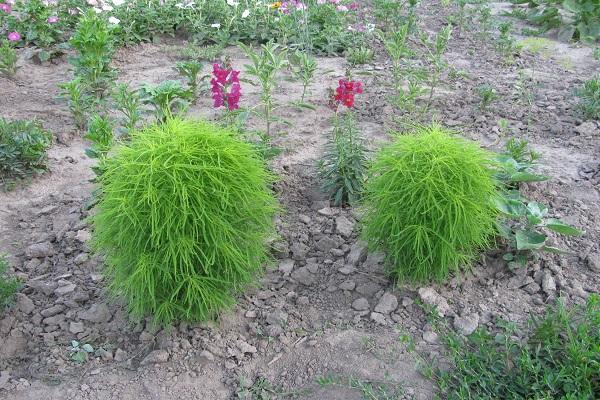
When is it better to plant a plant: optimal timing
It is advisable to plant a crop in early May. There should be no risk of recurring frost. The flora is thermophilic, can freeze out. Planting can be done at the beginning of summer, but not later, since the culture germinates quickly. In the South, landings are carried out in April or late March. Seedlings are pre-grown in room conditions, using boxes or containers.
Where is it better to plant kochia: selection of a place
The place should be spacious and open. Choose an area that is well lit by the sun, but a little shade is also possible. Do not plant a plant in full shade, otherwise it will lose its decorative appearance, the leaves will become pale.
Preparation of planting material kochii
Before planting kohija, seedlings or seeds are prepared. Depending on the technique, a number of manipulations are performed.
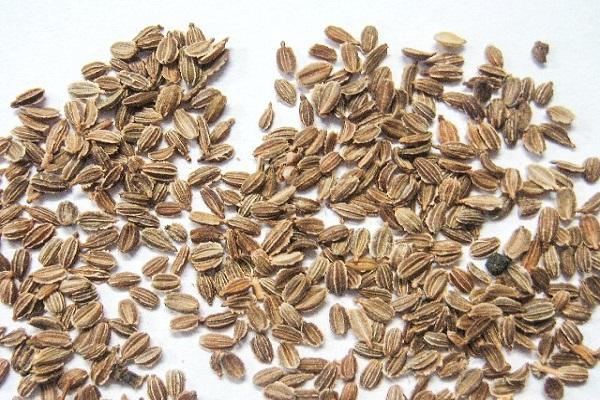
Cochia seeds
A drainage layer is laid out in the container so that the liquid does not stagnate. Pour the soil mixture on top, watered. Seeds are sown in rows, with a distance of 3-5 cm. After that, sprinkle with a thin layer of earth up to 1.5 cm. Cover with glass or cling film on top. After 7 days, the first shoots appear. They are ventilated, watered from a spray bottle. The cover can be removed after 1-2 weeks, and the seedlings can be looked after as for ordinary seedlings.
The desired temperature for the safe breeding of Kokhia seedlings is 25 degrees Celsius.
Saplings
The soil in individual pots should be the same; peat containers can be used. The soil with seedlings that have grown up to 10 cm is poured with warm water, gently undermining the soaked earth and the plant with a lump is transplanted into a pot. They put it on the windowsill, and in the evening they add lighting with a lamp. 1 week after transplanting, the seedlings are fertilized with growth stimulants. Further feedings are carried out once every 2 weeks before transplanting into the open ground. It is impossible to keep an overgrown bush in a pot for a long time, the root system needs space, otherwise the plant will fade.

Preparing the soil for kohija
The soil should be well-drained, allow oxygen and air to pass to the rhizome. Ideally, the acidity of the soil is neutral or slightly acidic. Before planting, plow the soil, remove weeds.
Planting scheme
Make the holes with a diameter corresponding to the size of the root system. Transfer the seedlings together with the earthen clod into the holes, press the soil with your hands, water. There should be a distance of 40-50 cm between the bushes.
Organization of competent care for kochia
The culture is unpretentious to care for, it is only important to periodically water the bushes, loosen the ground, cut them off. The last event is especially important.
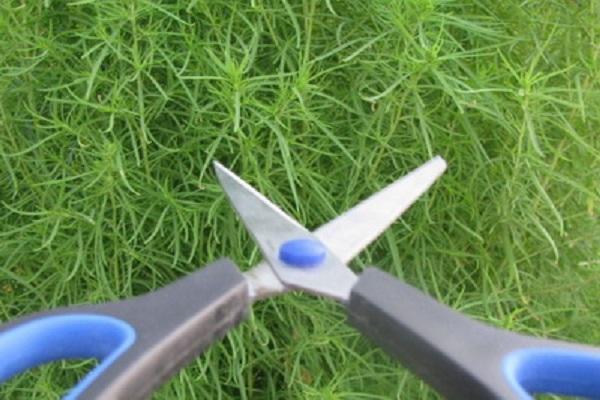
Watering the plant
Irrigate kohija in hot weather often, abundantly, every 2-3 days. Watering should be carried out in the morning or in the evening, after 16.00. If you irrigate the plant in full sun, there is a risk of leaf burns.
Top dressing of kochia
Kohia should be fertilized regularly so that it grows lush and does not hurt. The first feeding is carried out 2 weeks after planting. Further, every month the soil is fertilized with minerals or organic matter. You can use mullein, ash. Additionally, they feed the kochia after each pruning, so that it recovers faster.
Plant pruning
The kushiya tolerates the formation of the bush safely, you can use the procedure to give it the desired shape. Due to the rapid growth, it is possible to change the shape every 2 weeks.
Thinning kochii
When the bushes are overgrown, they can be made thinner with a thinning procedure. Dried, damaged branches are removed with a disinfected secateurs.
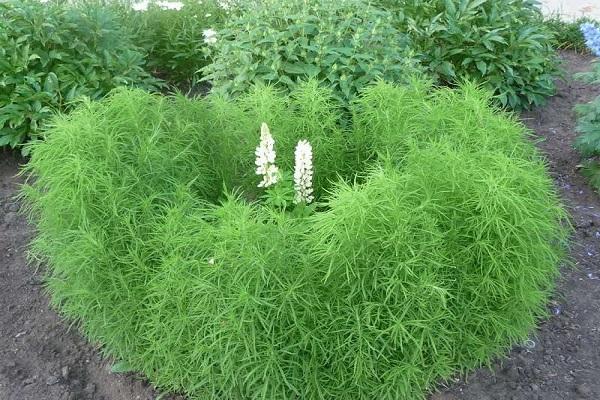
What pathologies and harmful beetles pose a danger to cochia
Kochia has strong immunity to various pathologies and harmful insects. If too frequent watering was carried out, rot is possible. Among the parasites, spider mites sometimes attack the bushes. Fight them by spraying with fungicides.
Collection and storage of seeds
To harvest the seeds, the bushes must be fully ripe. When they become burgundy, dry out a little, you can take seed. This usually happens in October or November. The inflorescences are cut off, small seeds are taken out of them.
They should be stored in a paper or cloth envelope in a dry place with an air temperature of up to 25 degrees Celsius..
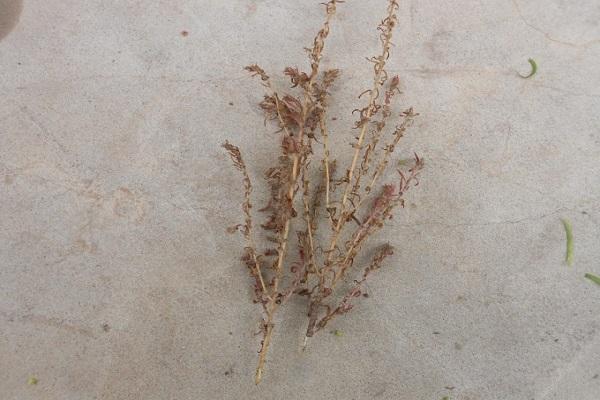
Application of kohija
The culture is used to decorate the site as a basic element. The plant also has healing properties, it is capable of treating some diseases.
Decorative properties
To decorate the cottage, single bushes are planted in flower beds, creating the desired shape of the bushes. You can combine several varieties by playing with the tones. Group planting of plants is used for the purpose of edging a lawn or decorating paths. Tall varieties can be used as hedges and for decorating entire territories. Emerald bushes are suitable for creating a background for plants blooming in bright colors. Thanks to the group planting, the effect of a vase is created. Tall cochias with bright inflorescences bloom in it. Variegated varieties with burgundy or purple foliage look best in the middle of the lawn.
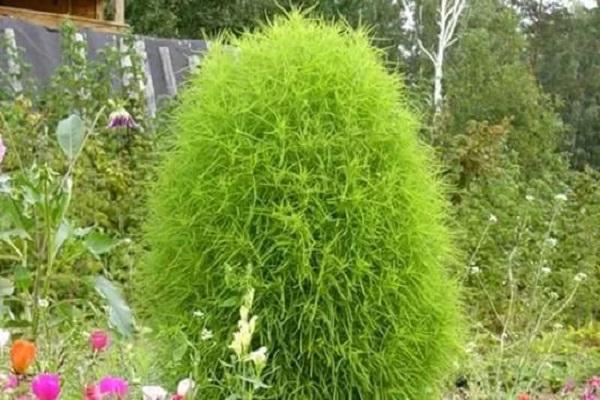
What is cochia used for in medicine
Kochia has a cardiac stimulating, diaphoretic and diuretic, general tonic effect.The plant is used to treat pathologies of the urinary canal, bladder, eczema, rheumatism, edema, inflammation of the skin. Cochia-based ointments treat dermatitis and nail diseases.
